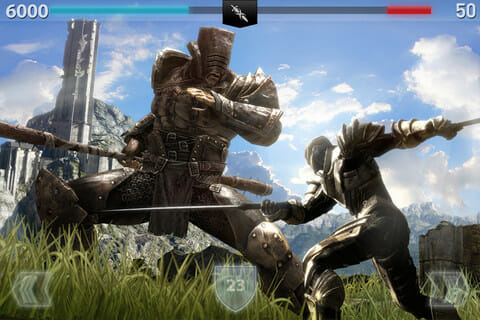Infinity Blade II (iOS)

“Who wants to live forever?” Freddie Mercury intoned on Queen’s soundtrack to the 1986 movie Highlander. He had a point. After a while, life has got to become awfully repetitive for an immortal, a procession of places, people, and events whose differences gradually dissolve as time passes. Le plus ça change and all that, into eternity.
Chair Entertainment’s Infinity Blade franchise—which, like Highlander, is also a sci-fi tale about an immortal swordsman—exploits that repetitiveness for both mechanical and narrative purposes. The original Infinity Blade, released in December 2010, was a watershed game in the mobile space, proving the iOS platform was capable of producing stunning visuals. Its Punch-Out!!-style gameplay, a series of one-on-one duels relying on timing and pattern recognition, creatively utilized iDevices’ touch screen interface. And the light RPG elements it included, especially its use of experience points to level up equipment as well as your character, provided the hook the game needed to keep players coming back to the same battles again and again. “Finally,” players and critics all seemed to be saying, “a real video game for iOS.”
A year later, Infinity Blade II appears, and it makes no less striking an impression. This is easily the prettiest game I’ve seen on iOS: its sweeping vistas, colorful landscapes, and detailed interiors are magnificently drawn, and expert use of the camera during the between-battle cutscenes creates a coherent sense of space. These scenes remain cleverly interactive; as in the first game, the player can play a sort of hidden object game to grab bonus gold and items between duels. Epic’s Unreal engine again flexes its muscle here, with animations on par with some console games’. While I don’t like the decision to substitute English for the original Infinity Blade’s fictional language—the dialogue and plot feel a lot less mysterious when delivered in ordinary speech—the soundtrack is haunting enough to compensate.
Although a different narrative conceit is used to explain it, Infinity Blade’s core combat-death-rebirth formula is intact in the sequel. The player progresses through a series of duels with giant, exotically-styled Titans as he advances through a castle, acquiring experience and equipment along the way. If you die, you can reload your last save or choose to be reborn at the beginning of the sequence, keeping any equipment, experience, and gold you’ve earned. (Apparently the Titans very kindly return all your stuff to you in between lives.) The addition of sub-bosses adds challenge and varies your journey by splitting it into different paths. Seeing a new path open up for the first time is probably more affecting than it should be, but that’s the power of the repetitive structure—anything new is immediately meaningful.
Combat controls are again precise, as you dodge, parry, and block enemy attacks before countering with your weapons and magic. As in the first game, Infinity Blade II sometimes seems to confuse swipes for dodging and parrying, but the new feature allowing you to shrink the dodge virtual buttons is welcome. The user interface is even more attractive and intuitive this time around, with easily navigable menus. Aside from the occasional framerate hiccup, I experienced very little instability on my first-generation iPad; as with most memory-hungry iOS games, a hard reboot after install should fix any launch crash issues.
It’s interesting to note how iteration has helped refine a game whose core mechanic is, well, iteration. Infinity Blade II includes a light crafting system, letting you slot gems into your weapons and armor to provide buffs. More complexity is added by the new tiers of weapons. Instead of being stuck with sword and shield, you can now fight with heavy two-handed weapons like hammers or dual-wield smaller blades. These changes are more than cosmetic, as they alter your abilities during combat. Although you can’t dodge with a heavy weapon equipped, you can do massive damage. You can’t block with dual-wielded weapons equipped, but you can rack up long combo strikes. The enemies themselves are more varied and have plenty of new attack animations, making their strikes more challenging to anticipate and counter. There’s a bit of strategic thinking needed to decide which weapon set to deploy against different enemy types.

